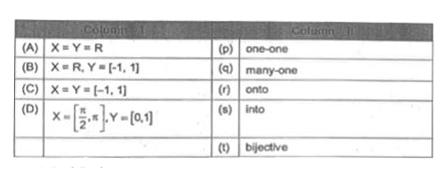Let A = {x, y, z), B = {u, v, w} and f : A → B be defined by f(x) = u,
f(y) = v, f(z) = w. Then, f is
surjective but not injective
injective but not surjective
bijective
None of the above
The correct Answer is:C
To determine the nature of the function f:A→B defined by f(x)=u, f(y)=v, and f(z)=w, we will analyze whether the function is one-to-one (injective) and onto (surjective).
Step 1: Identify the sets and the function
Let:
- A={x,y,z}
- B={u,v,w}
- The function f is defined as:
- f(x)=u
- f(y)=v
- f(z)=w
Step 2: Check if f is one-to-one (injective)
A function is one-to-one if different elements in the domain map to different elements in the codomain.
- Here, we have:
- f(x)=u
- f(y)=v
- f(z)=w
Since u, v, and w are distinct, it follows that:
- f(x)≠f(y)
- f(x)≠f(z)
- f(y)≠f(z)
Thus, f is one-to-one.
Step 3: Check if f is onto (surjective)
A function is onto if every element in the codomain has a pre-image in the domain.
- The codomain of f is B={u,v,w}.
- The range of f is also {u,v,w} since:
- f(x)=u
- f(y)=v
- f(z)=w
Since the range of f is equal to the codomain B, we conclude that f is onto.
Step 4: Conclusion
Since f is both one-to-one and onto, we can conclude that f is a bijective function.
Final Answer
Thus, the function f is bijective.
---
Let:
- A={x,y,z}
- B={u,v,w}
- The function f is defined as:
- f(x)=u
- f(y)=v
- f(z)=w
A function is one-to-one if different elements in the domain map to different elements in the codomain.
- f(x)=u
- f(y)=v
- f(z)=w
- f(x)≠f(y)
- f(x)≠f(z)
- f(y)≠f(z)
A function is onto if every element in the codomain has a pre-image in the domain.
- The range of f is also {u,v,w} since:
- f(x)=u
- f(y)=v
- f(z)=w
Since f is both one-to-one and onto, we can conclude that f is a bijective function.
Thus, the function f is bijective.
Topper's Solved these Questions
- BOOK - ARIHANT MATHS ENGLISHCHAPTER - SETS, RELATIONS AND FUNCTIONS EXERCISE - Exercise (More Than One Correct Option Type Questions)3videos
SETS, RELATIONS AND FUNCTIONS
- BOOK - ARIHANT MATHS ENGLISHCHAPTER - SETS, RELATIONS AND FUNCTIONS EXERCISE - Exercise (Passage Based Questions)6videos
SETS, RELATIONS AND FUNCTIONS
- BOOK - ARIHANT MATHS ENGLISHCHAPTER - SETS, RELATIONS AND FUNCTIONS EXERCISE - Exercise For Session 310videos
SETS, RELATIONS AND FUNCTIONS
- BOOK - ARIHANT MATHS ENGLISHCHAPTER - SEQUENCES AND SERIESEXERCISE - Exercise (Questions Asked In Previous 13 Years Exam)38videos
SEQUENCES AND SERIES
- BOOK - ARIHANT MATHS ENGLISHCHAPTER - THE STRAIGHT LINESEXERCISE - Exercise (Questions Asked In Previous 13 Years Exam)17videos
THE STRAIGHT LINES
Similar Questions
Let A={x,y,z}=B={u,v,w)andf:A→B be defined by f (x)=u,f(y)=v,f(z)=w. Then, f is
View SolutionLet f : N→N be defined as f(x) = 2x for all x∈N, then f is
View SolutionA function f:R→ defined by f(x)=x2. Determine
{y:f(y)=−1}View SolutionLet f:X→Y be a function defined by f(x)=sinx.
 View Solution
View SolutionLet f={(1,1),(2,3),(0,1),(1,3)}be a function from Z→Z defined by f(x)=ax+b, for some integers a,b.
Determine a,b.View SolutionLet A=R−{3},B=R−{1} and f:A→B defined by f(x)=x−2x−3. Is 'f' bijective? Give reasons.
View SolutionLet f:R→R be a function defined as f(x)=x2−6x2+2, then f is
View SolutionLet A=R−{3},B=R−{1}, and let f:A→B be defined by f(x)=x−2x−3 is f invertible? Explain.
View SolutionLet f:Z→Z be defined by f(x)=x+2. Find g:Z→Z such that gof=IZ .
View SolutionLet f:Z→Z be defined by f(x)=x+2. Find g:Z→Z such that gof=IZ .
View Solution

